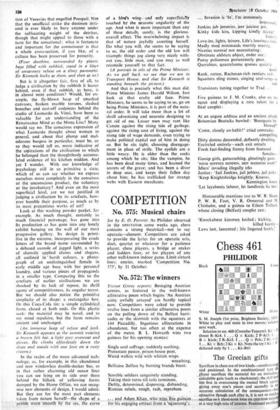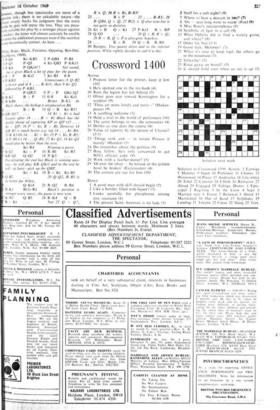Chess 461
PHILIDOR
S. M. Joseph (1st prize, Brighton Society, 18951. White to play and mate in two moves; solution next week.
Solution to no. 460 (Coombe-Tennant). Kt x P, threat R—Kt4. 1 . . . Q x Ktch; 2 P—Kt3. 1 .. • B x Ktch; 2 R—Kt3. 1 Q x Pch; 2 Kt x ... Kt x Bch; 2 Kt x Kt. Note the try I Kt Y. B•' defeated only by 1 ... Kt—R6!
The Grecian gifts
Sacrifices in chess are of two kinds—combination21 and positional. In the combinational type the player sacrifices the material for an immedix calculable gain (such as checkmate); the skill hoe lies first in overcoming the mental block again: giving away one's pieces and secondly in 1114 accurate calculation of the consequences—hut. attractive though such play is, it is not so mucha sacrifice as-a short-term loan on cast-iron seam at a very high rate of interest. Positional sacrifices, however, though less spectacular are more of a genuine risk; there is no calculable return-the layer simply backs his judgment that the extra -we he gets will repay the loss. They are pecu- liarly suitable for play by a stronger player against weaker; the latter will almost certainly be unable o resist the additional pressure even if the sacrifice not theoretically correct. As here ...
White, Bajec. Black, Forintos. Opening, Ben-Oni. Ljubljana, 1969). P-Q4 Kt-KB3 2 P-QB4 P-B4 3 P--Q5 P-Q3 4 Kt-QB3 P-KKt3
5 p-K4 P-QKt4!? Not sound,
but it gives Black a lot of play for the pawn.
6 P x P B-Kt2 7 Kt-B3 0-0
8 P-KR3 • • Unnecessary. 8 Q-B2 is better and if 8 . . . B-Kt5; then 9 Kt-Q2 followed by .P-KB3.
P-QR3! 9 P x P QKt-Q2 0 B-K2 B x P 11 0-0 Kt-Kt3
2 B-KB4 Better B-K3. As Black shows, the bishop is misplaced on B4.
2 B x B 13 Q x B Kt-R5!
4 QR-Q1? . . . 14 Kt x Kt is bad because after 14 . . . R x Kt Black has the double threat of capturing KP or QP (15 . . . Kt x QP; 16 P x Kt, R x B). However 14 QR-B1 is much better e.g. (a) /4 . . . Kt-R4;
15 B-K3 (h) 14 . . . Kt x Kt; 15 P x Kt, R-R5; 16 P-B4 (c) 14 . . . Q-R4; /5 Kt-Q1 . 14 Kt-Q1 would also be better than the text.
Kt-R4 Winning a pawn.
B-Q2 Kt x P 16 R-B1 Kt-R5 KR-Q1 Q-Q2 18 P-K5 Precipitating the end but Black is winning any- war-he will play KR-Q1(11 and in the end he will-at least-pick up the QRP.
Kt x Kt 19 B x Kt Kt-B5
Q-B2 ... 20 Q-Q2, R-R5 is no better for White.
Q-Kt4 21 R-Q2 R-R6
R-K1 R(1)-R1 Black's position is
stronger every move; the game is now won.
K-R2 Q-B5 24 R-K4 Q x B
R x Kt .. . Not 25 Q v Q ?,
R x Q; 26 R x Ks, B-R3!
25 ... B x P 25 . . . B-R3; 26 R-QB4, Q x Q; 27 .12(2) X Q also wins but is not quite so decisive.
26 Kt x B Q x Kt 27 P-Kt3 R x RP
28Q-Q3 ... 28 Q x R, R x Q; 29 R x R, Q x Pis also quite hopeless.
28 ... R x R 29 Q x R R-R8
30 Resigns. Two pawns down and in the inferior position, White rightly decides to call it a day.



































 Previous page
Previous page